
With the various particle size analysis equipment on the market, picking a solution for your operation can be difficult. This guide was created to provide insight into everything you need to know about theRO-TAP Sieve Shaker and help determine if it's right for your particle analysis process.
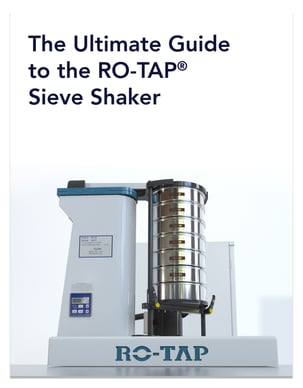
Looking for something specific? Use the buttons below to be directed to a particular subject.
To gain a full comprehension of what a RO-TAP Sieve Shaker is, you must first understand what sieve shake means in the world of particle size analysis. Sieve shaker is an industry term for a machine that is used to separate particles.

These machines were created to get consistent, repeatable results that are more reproducible than hand sieving.
Sieve shakers themselves aren't exclusive to a particular company, brand, or model. With that, a RO-TAP is the W.S. Tyler branded version of a sieve shaker.
Think of it as a Kleenex. When you ask for a Kleenex you are actually asking for a tissue; however, because Kleenex it’s such a widely known brand name, we use it interchangeably with the word tissue.
A RO-TAP is a particle size analysis instrument that is designed for use in a wide range of industries to test and separate particles.
Test sieves are best defined as a screening medium, with uniform opening size and shape, mounted on a rigid frame. In other words, it is a tool that uses woven wire mesh to separate particles from materials.
Now, test sieves consist of a wire mesh screen that is affixed to a round, metal frame and comes in various sizes and specs. In most cases, the exact test sieve you need as specified by your industry standard, which will be discussed later.

To ensure you continue to yield reliable results, it is recommended to utilize two sets of sieves: a master set and a working set.
All particle size analysis testing is to be performed on your working sieves, using the master sieves to periodically ensure your working sieves are performing as they should be. Think of them as a means of quality control that allows you to verify the effectiveness of your working sieves in-house.
Master sieves are commonly certified to your industry standard and should be certified at least once a year to ensure that they still comply with these standards.
To put it simply, sieve shakers are first loaded with a stack of sieves at which point it begins to shake the stack, causing the particles of the material to pass through the opening in the sieves until the particle reaches an opening that is too small. An oscillating motion is used to promote this process.

While the RO-TAP was designed to test 1 to 13 sieves at a time, using a 13-sieve stack is fairly uncommon and would need to be half-height sieves. Using 6, full-height sieves in a stack is the most common and preferred test sieve analysis method.
Having been around for decades, mechanical sieve shakers are easily the most widely used type of sieve shakers. Alongside the oscillating motion that encourages particles to make their way through the sieve stake, mechanical test sieves employ a hammer that sits on top of the unit and taps the sieve stack to help particle movement further.
It should be noted that these machines are fairly loud. In fact, they run at around 85 decibels.
To combat this, you can incorporate a sound enclosure.
Electromagnetic sieve shakers provide a modern perspective of the mechanical sieve shakers in the fact that test sieve shakers utilize a state-of-the-art 3D motion to promote particle movement through the sieve stack rather than the hammer of a traditional test sieve.
The omission of the hammer makes these units a quieter and easier to maintain solution. They also feature an ergonomic design allowing them to fit virtually any lab setting.
Once the correct test sieves for your process have been selected, you simply turn on the machine and select a test time that complies with your industry standards. Once the sieve shaker has completed its cycle, you must analyze each sieve to determine how much material was retained. The length in which you should run your sieve shaker will be discussed later.
While these units are fairly easy to operate, they require a bit more know-how than mechanical sieve shakers.
Electromagnetic Sieve Shakers, such as the RO-TAP E Premium, are fully customizable and grant you full control of the way the shaker separates your particles by simply adjusting the amplitude and interval of the motion pauses that guide the particles through the mesh.
Premium units can even store Standard Operating Procedures (SOPs), using the amplitude and intervals that adhere to industry standards, depending on the material you are working with. This eliminates the need to manually set up each test.
Mechanical sieve shakers are typically larger than electromagnetic units. The RO-TAP RX-29, for example, has a footprint of 28” wide x 21" deep x 25” high and weighs approximately 170 pounds. Of course, this footprint increases when accompanied by a sound enclosure cabinet.
Electromagnetic units typically have a footprint of 14” wide x 12” deep x 37” high and weigh approximately 80 pounds.
As stated above, RO-TAP sieve shakers use a tapping and rotating motion to separate particles.
As a result, these units produce an 85 dB noise level but can be reduced to around 78db when inside a sound enclosure cabinet.
As electromagnetic sieve shakers utilize a vibrating motion instead of the hammer tap action of a mechanical sieve shaker, they are vastly quieter when operating.
In fact, the noise levels of electromagnetic models seldomly exceed 70 dbs.
RO-TAP-RX29 and RX-30 are possibly the most commonly used sieve shakers. While the two models are virtually the same, the main difference is that the RX-29 is designed to work with 8-inch test sieves whereas the RX-30 is designed to work with 12-inch test sieves. 3-inch and 6-inch diameter test sieves can also be used with the RX-29 model if you utilize a conversion kit.

|
RX-29: $2,356.65 RX-30: $2,696.20 |
*International Customers: your electrical requirements may vary, call for pricing
This model has a similar form factor of the RX-29 and RX-30; however, this particular model can house two 8-inch sieve stacks instead of one. This means you can run two tests at one time.
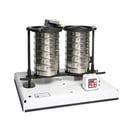 |
Cost: $3,902.35 |
This model was designed with coarse particles (80 mesh and coarser), such as aggregate, in mind. Using a sieve adapter, this unit can conduct particle size analysis with 8-inch as well as 12-inch test sieve. It should be noted that the only agitation that occurs is produced by the oscillating motion.
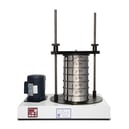 |
Cost: $1,237.25 |
This electromagnetic sieve shaker was designed to be simple and quick to use, employing only two amplitude levels for either coarse or fine material. This unit should only be used for standard, dry sieve analysis.
This model is compatible with both 8- and 12-inch test sieves.
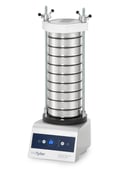 |
8” - $4,125 12” - $6,574.60 |
This unit provides the addition of a control panel that allows the operator to set their own amplitude and interval of sieving motion. Like the E Pure, this model should only be used for traditional dry sieving. This model is compatible with both 8- and 12-inch test sieves.
 |
8" - $4,862.15 |
This unit was designed for those who want to conduct wet sieve analysis but don’t want to forfeit the benefits of an electromagnetic sieve shaker. It utilizes two hoses (included with purchase): one is used as the waterline and the other for drainage. To prevent water damage, the control panel is separated from the body of the unit.
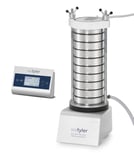 |
8" - $5,446.30 |
|
A representative sample is simply a portion of the material passing through a production line and is the first step to conducting a reliable particle size analysis. But why is it so important to prepare a representative sample? |
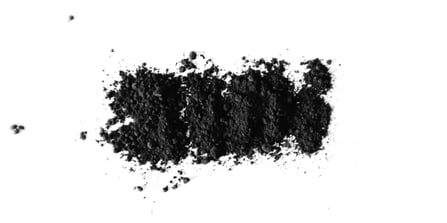 |
If you were to take a large sample from the production line and pour it out, the larger particles would fall on the outside and the small particles would accumulate in the middle of the pile. Taking a sample from this pile would result in mostly coarse particles being tested, which would not accurately represent the material on the production line.
Testing every single particle in your production line is never an efficient solution. This is just another reason that gathering a reliable representative sample is vital to any particle size analysis process.
The best way to gather a sample that accurately represents the production line is to use the coning and quartering method.
1. Pour your material onto a clean flat surface. Once you do this it will naturally result in a “cone” shape.
2. Using a large shovel or another suitable tool, turn the entire sample over at least 3 times and form the entire sample into a conical pile
3. Flatten the material to have a circle uniform in thickness (typically done with a shovel)
4. Cut the pile into 4 identical quarters
5. Remove two opposite corners
Now, it is not recommended to use material directly from trucks or rail cars, as there are too many factors that can impact the gradation of the material like segregation or particle breakdown during the loading, transporting and unloading.
It is best to test the material once it has been delivered.
Once a representative sample has been gathered, it may not be broken down enough to run through a RO-TAP Sieve Shaker. If this is the case, you’ll need a way to divide the sample into more manageable portions, while also preserving its accuracy.
This is where a material splitter comes into play.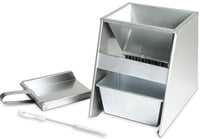
A material splitter divides your particles into two samples that are identical in size. To use a material splitter, simply pour your material into the top of the splitter, ensuring you are evenly pouring the material from right to left.
Before you begin a test sieve analysis, there are few preliminary steps that you must take. First, you must gather your representative sample.
 For the next part of this process, you must prepare your sieve stack in accordance with your industry standards. Different materials require different opening sizes to achieve an accurate and reliable particle size distribution.
For the next part of this process, you must prepare your sieve stack in accordance with your industry standards. Different materials require different opening sizes to achieve an accurate and reliable particle size distribution.
The final step is to calculate how long you must run your sieve shaker. Typically, a thorough test sieve analysis will take around 10 to 15 minutes.
The best way to calculate how long to run sieve shakers is to conduct an end of sieving analysis. This will determine the minimum amount of time required to yield consistent results.
Use the following steps to guide you through your next end of sieve analysis:
1. Start with the actual sieves and a typical sample of the material that will be tested.
2. Select an initial test time, usually 3-5 minutes, and run a sieve analysis.
3. Record the amount of sample retained (or passed, if that is the result typically recorded) on each sieve.
4. Using the same sieves and sample, run the test again incrementally longer, usually adding 1-5 minutes to the initial test time.
5. Again, record the results of the sieve analysis.
6. Repeat this process adding incrementally more time to the RoTap timer until the results of the sieve analysis stop changing by more than 0.5%-1%.
7. This is the end of sieving, running the test any longer will not significantly affect the results of the analysis.
The following steps should be followed to produce optimal test sieve analysis results:
1. Place your sieve stack (without the sample material) in your sieve shaker.
2. Pour your representative sample into the top sieve of your sieve stack. Try and pour your sample as evenly around the surface of the top sieve as possible.
3. Once the representative sample has been poured in its entirety, place the test sieve lid on. This lid is used to prevent the sample material from falling off the edges and, in addition, is not durable enough to withstand the tapping of the sieve shaker hammer (performs tapping motion).
4. A second, more robust lid (see below images) is placed on top of the test sieve lid to soften the impact.
5. Now you can drop the hammer into place.
6. You are now ready to turn your machine on and set your timer. Once the sieve shaker has finished its cycle, it will turn itself off.
In order to properly generate test sieve analysis results, you must weigh the amount of sample material retained on each sieve in the stack. If your test sieve analysis was conducted correctly, the numbers should add up to the beginning weight of your sample.

That said, the most common method for analyzing test sieve analysis results is to calculate the percentage of material that passed through the sieve stack. This can be done by determining the amount of material that has passed through the top sieve
and recording it, repeating this process until you have analyzed the sieve stack in
its entirety.
To simplify this process, you can input your results into specialized W.S. Tyler software. The software takes the retained weight results that you provide and, in return, generates both a retained weight percentage as well as a particle distribution curve. If this interests you, the price of the software is $30.
ASTM International stands as one of the largest standard regulating organizations in the world and is responsible for creating the standards for materials, products, systems, and services that affect your particle size analysis process in some way.
ASTM membership is made up of hundreds of producers, users, consumers, government, and academia spanning across over 140 countries. These volunteers work to develop the technical documents that serve as the basis of the manufacturing, management, procurement, codes, and regulations that affect dozens of industries.
ASTM is often listed within other Standards as a supportive document
ASTM E11 oversees the production of test sieves, setting the standards for mesh openings, wire diameters, frame size, and cloth mounting requirements.
This standard ensures that users in any industry can be certain that their sieves will produce repeatable, consistent results.
ISO has published 22,701 International Standards and related documents, covering almost every industry, from technology to food safety to agriculture and healthcare.
The International Organization for Standardization (ISO), is based in Switzerland and shares similar qualities as the U.S. ASTM, as they both utilize expert collaboration to share knowledge and develop voluntary, consensus-based, market-relevant International Standards that promote innovation and generate solutions to obstacles seen all over the world.
Governing the requirements for mesh size, construction materials, and tolerances in test sieves, the ISO standard that regulates test sieve manufacturing is ISO 3310-1:2016.
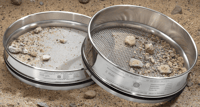 AASHTO is an international leader that sets the technical standards for all phases of highway system development. These standards govern design, construction of highways and bridges, materials, and all the technical detail in between.
AASHTO is an international leader that sets the technical standards for all phases of highway system development. These standards govern design, construction of highways and bridges, materials, and all the technical detail in between.
To ensure the uniformity of asphalt, cement, and concrete used to construct U.S. road systems, they have developed several standard guides for particle size analysis that refer to the guidelines surrounding sieve sizes and material testing requirements.

The American Petroleum Institute regulates the natural gas and oil industry. As the uniformity of size and shape, including sphericity and circularity, is critical in this industry, they have developed standards that regulate the specifications of the silica sand used in hydraulic fracturing, or fracking. This standard details the different particle size distributions required for each grade of sand which is verified using test sieves.
There are cases in which a particular material has yet to be associated with a standard. If this is the case and the general particle size of the material is known, having a mix of ASTM E11 standard test sieves, both above and below the nominal size, can help calculate the efficiency of your test sieve analysis process.
Once a mix of particles reaches a desirable performance, the quality of future production lines can be checked using sieves to verify the particle size distribution.
To gather more insight into various testing methods for material without a standard, you should search the websites of the organizations for similar materials.

Initial setup begins with taking the RO-TAP unit itself out of the box in which it was shipped in. As the average weight range of an RO-TAP is from 90 to 180 LBS depending on which model you select, we highly recommend that you have a co-worker assist you.
If you are using an RX-29, RX-30, or an RX-94 model, you will need to check the hammer height to ensure it complies with the number of sieves in your stack. If hammer adjustment is required, you simply use a T-Square to ensure the height of the hammer is 1 5/16”.
Once this is complete, all there is left to do is to load a sieve stack into the RO-TAP, place the sieve cover on top of the stack, plug it in, power it on, and begin yielding accurate results.
When incorporating any of the RO-TAP models into a lab setting, it is vital that you attach it to a table that is sturdy enough to withstand both the weight and oscillating motion of the unit. You must also make sure you order the correct electrical configuration for the outlets in your facility.
Each RO-TAP unit comes with a 1-year guaranteed warranty that starts once the unit is powered on for the first time. Under the warranty, any manufacturing malfunctions will be fixed at no charge within the year time frame.
After the first year, it is up to the on-site team to maintain a regular maintenance schedule to avoid issues, such as unusually loud equipment. Placing oil on some of the bushings and checking the moving parts every few months are simple maintenance techniques that will keep your operation up and running.
With that, we recommend you keep at least one maintenance kit on hand to minimize any downtime you may encounter after the warranty has expired.
We don’t predict you will need to change out any of the parts on your sieve shaker during the first year or so; however, as any machine would, some parts may become worn and need to be replaced.

We have three different maintenance kits available. Each one offers the parts that commonly need to be replaced.
These maintenance kits allow you to quickly replace your parts and get your machine back up and running.
Minor Maintenance Kit: $103.25
This kit includes the top six most needed replacement parts for all mechanical sieve shakers.
- 2 Eccentric Discs
Major Maintenance Kit: $480.55
This kit is for the RX-29 and RX-30 and includes the seven parts from the minor maintenance kit above plus:
- 1 Timing Belt
- 1 Upper Carrying Plate
- 1 Cam Gear
- 1 Timing Belt Pulley
RX-94 Maintenance Kit: $396.30
This maintenance kit is specifically for the RO-TAP RX-94 and includes the same parts as the major maintenance kit except for the upper carrying plate.
Should you run into an issue and require technical support, you can use the contact information listed above to reach out to our team who will gladly assist you. That said, you should have the following information ready when a W.S. Tyler team member contacts you:
- Serial number or model number
- Where your RO-TAP unit is located in your building
- The electrical combination you are using
- How many sieves you are using at a time
Sieve shakers and test sieves alike are essential to the quality control of countless industries. As a result, they can be traced to industry standards all over the globe.
While you can apply sieve shakers however you see fit, the fact that they were not designed to be used in applications that place directly in the production line should be taken into consideration. With that, it is not recommended to use them in such a way.
The estimated lifespan of these products was generated based on the idea of small sample testing and not the analysis of each particle in the production line.
Test sieves can and should be certified to comply with the standards we addressed above.
However, it should be noted that, as of now, no known standards have been developed to regulate sieve shakers. There are specific requirements that a sieve shaker must follow to comply with industry standards. To put it simply, a RO-TAP Sieve Shaker can not be officially certified or calibrated at this time.
To ensure you are getting the best possible results, you can refer to the manufacturer’s specifications to verify your equipment is running in accordance to its factory specifications.
- Oscillations Displacement 1-1/8” x 7/16”
- Taps per minute 150±10
- Hammer Weight: 5 lbs 6 oz.
- Electric Motor Rating: NEMA Nom. Eff. 64 / P.F. 61
- Draws 4.4 Amps
The W.S. Tyler RO-TAP Sieve Shaker was designed to help facilitate accurate and reliable test sieve analysis. Available in both mechanical and electromagnetic variants, the RO-TAP creates an oscillating and tapping motion to promote particle movement through a test sieve stack and yield results that represent your production line.
Having been regarded as one of the best instruments on the market since the early 1900s, it has been written into dozens of industry standards, making it an ideal fit for most particle size analysis operations. With 7 different models ranging from $1,237 - $6,600, implementing a RO-TAP is made easy.
While there is some regular maintenance required, implementing a RO-TAP Sieve Shaker will help to ensure your particle size analysis process continues to deliver a desirable level of quality control. Of course, if you ever need further assistance our team of experts is here to help.